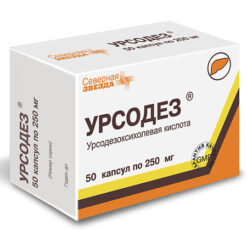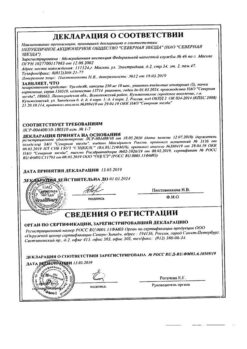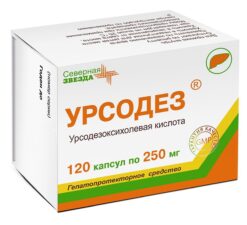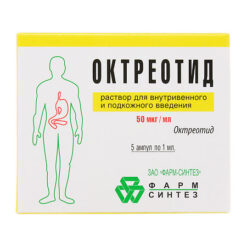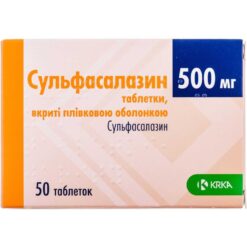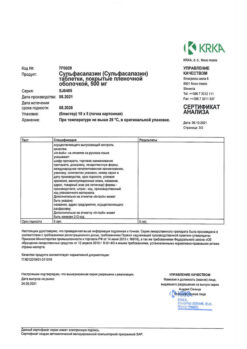No products in the cart.
Ursodeoxycholic acid-Vertex, 250 mg capsules 100 pcs
€37.47 €31.22
Description
Pharmacotherapeutic group: Hepatoprotective drug
ATC code: A05A02
Pharmacological properties
Pharmacodynamics
Indications
Indications
– dissolution of cholesterol gallstones;
– biliary reflux gastritis;
– primary biliary cirrhosis of the liver in the absence of signs of decompensation;
– chronic hepatitis of various origins;
– primary sclerosing cholangitis;
– cystic fibrosis (cystic fibrosis);
– non-alcoholic steatohepatitis;
– alcoholic liver disease;
– biliary dyskinesia.
Pharmacological effect
Pharmacological effect
Pharmacotherapeutic group: Hepatoprotective agent
ATX code: A05AA02
Pharmacological properties
Pharmacodynamics
Special instructions
Special instructions
The drug should be taken under the supervision of a physician.
During the first 3 months of treatment, liver function indicators should be monitored: transaminases, alkaline phosphatase and gamma-glutamyl transpeptidase in the blood plasma every 4 weeks, and then every 3 months. Monitoring these parameters makes it possible to identify liver dysfunction in the early stages. This also applies to patients in the later stages of primary biliary cirrhosis. In addition, it can quickly determine whether a patient with primary biliary cirrhosis is responding to treatment.
When using the drug to dissolve cholesterol gallstones
In order to assess progress in treatment and in order to timely detect signs of calcification of stones depending on their size, the gallbladder should be visualized (oral cholecystography) with examination of opacities in the standing and supine position (ultrasound examination) 6-10 months after the start of treatment.
If the gallbladder cannot be visualized on x-rays, as well as in cases of calcification of stones, poor contractility of the gallbladder or frequent attacks of colic, the drug should not be used.
Patients taking ursodeoxycholic acid to dissolve gallstones should use effective non-hormonal methods of contraception, since hormonal contraceptives may increase the formation of gallstones (see sections “Interaction with other drugs” and “Use during pregnancy and breastfeeding”).
When treating patients in the later stages of primary biliary cirrhosis
Cases of decompensation of liver cirrhosis have been reported extremely rarely. After cessation of therapy, a partial reverse development of the manifestations of decompensation was noted.
In patients with primary biliary cirrhosis, in rare cases, at the beginning of treatment, clinical symptoms may increase, for example, itching may increase. In this case, the dose of the drug must be reduced and then gradually increased again, as described in the “Method of administration and dosage” section.
When used in patients with primary sclerosing cholangitis
Long-term therapy with high doses of ursodeoxycholic acid (28-30 mg/kg/day) in patients with this pathology can cause serious side effects.
In patients with diarrhea, the dose of the drug should be reduced. If diarrhea persists, treatment should be discontinued.
Effect on the ability to drive vehicles and machinery Ursodeoxycholic acid does not affect the ability to drive vehicles and machinery, or the effect is minimal.
Active ingredient
Active ingredient
Ursodeoxycholic acid
Composition
Composition
One capsule contains:
active ingredient: ursodeoxycholic acid – 250 mg;
excipients: corn starch – 63 mg, povidone K-30 – 10 mg, colloidal silicon dioxide – 5 mg, magnesium stearate – 2 mg;
hard gelatin capsules: titanium dioxide – 2.0%; gelatin – up to 100%.
Pregnancy
Pregnancy
Pregnancy
There are limited or no data on the use of ursodeoxycholic acid during pregnancy. Animal studies have shown reproductive toxicity in early pregnancy.
Ursodeoxycholic acid should not be used during pregnancy unless clearly necessary.
Fertility
According to animal studies, ursodeoxycholic acid has no effect on fertility. There are no data on the effects of ursodeoxycholic acid treatment on fertility in humans.
The use of the drug by women of childbearing age is possible only if they use reliable methods of contraception. It is recommended to use non-hormonal contraceptives or oral contraceptives with low estrogen content. However, patients taking ursodeoxycholic acid to dissolve gallstones should use effective non-hormonal contraceptives as hormonal oral contraceptives may increase gallstone formation. Before starting treatment, possible pregnancy should be excluded.
Breast-feeding
Based on several documented case reports, the level of ursodeoxycholic acid in breast milk in women is very low and therefore adverse reactions are not expected to occur in breastfed infants.
Contraindications
Contraindications
– hypersensitivity to the components of the drug and other bile acids;
– X-ray positive (high calcium content) gallstones;
– violation of the contractility of the gallbladder;
– blockage of the bile ducts (blockage of the common bile duct or cystic duct);
– frequent episodes of biliary colic;
– acute inflammatory diseases of the gallbladder and bile ducts;
– cirrhosis of the liver in the stage of decompensation;
– severe liver and/or kidney failure;
– children under 3 years of age (not recommended for use in this dosage form).
Pediatric population
– unsuccessfully performed portoenterostomy or cases of failure to restore normal bile flow in children with biliary atresia.
Ursodeoxycholic acid has no age restrictions for use, but children under 3 years of age are recommended to use the drug in the form of a suspension, as difficulties may arise when swallowing capsules.
With caution
Children over 3 years of age (may have difficulty swallowing capsules).
Side Effects
Side Effects
Classification of the incidence of side effects according to the recommendations of the World Health Organization (WHO):
very often ≥ 1/10;
often from ≥ 1/100 to < 1/10; infrequently from ≥ 1/1000 to < 1/100;
rarely from ≥ 1/10000 to < 1/1000;
very rarely <1/10000, including isolated reports;
frequency unknown – based on available data, it is not possible to determine the frequency of occurrence.
Gastrointestinal disorders:
often – loose stool or diarrhea;
very rarely – acute pain in the right upper abdomen (in the treatment of primary biliary cirrhosis).
Disorders of the liver and biliary tract:
very rarely – calcification of gallstones, decompensation of liver cirrhosis, which disappears after discontinuation of the drug (in the treatment of advanced stages of primary biliary cirrhosis).
Disorders of the skin and subcutaneous tissues:
very rarely – allergic reactions, including urticaria.
Interaction
Interaction
Cholestyramine, colestipol, and antacids containing aluminum hydroxide or smectite (aluminum oxide) reduce the absorption of ursodeoxycholic acid in the intestine and thus reduce its absorption and effectiveness. If the use of drugs containing at least one of these substances is still necessary, they should be taken at least 2 hours before taking ursodeoxycholic acid.
Ursodeoxycholic acid may affect the absorption of cyclosporine from the intestine. Therefore, in patients taking cyclosporine, the doctor should check the concentration of cyclosporine in the blood and, if necessary, adjust its dose.
Ursodeoxycholic acid may reduce the absorption of ciprofloxacin.
In a clinical study in healthy volunteers, co-administration of ursodeoxycholic acid (500 mg/day) and rosuvastatin (20 mg/day) resulted in a slight increase in rosuvastatin plasma levels. The clinical significance of this interaction, including with other statins, is unknown. In healthy volunteers, ursodeoxycholic acid has been shown to reduce peak plasma concentrations and area under the pharmacokinetic curve.
“concentration-time” of the slow calcium channel blocker – nitrendipine. In case of concomitant use of nitrendipine and ursodeoxycholic acid, careful monitoring is recommended. The dose of nitrendipine may need to be increased.
There are also reports of interactions with dapsone, which led to a decrease in the therapeutic effect of the latter. These observations, along with data from in vitro experiments, suggest that ursodeoxycholic acid is capable of inducing enzymes of the cytochrome P450 3A system. However, in a designed interaction study with budesonide, which is a known substrate of cytochrome P450 3A, no induction was noted.
Estrogen hormones and cholesterol-lowering drugs such as clofibrate increase cholesterol secretion in the liver and therefore may stimulate the formation of gallstones, which counteracts the effect of ursodeoxycholic acid, which is used to dissolve gallstones.
Overdose
Overdose
In case of overdose, diarrhea is possible. As a rule, other symptoms of overdose are unlikely, since as the dose increases, the absorption of ursodeoxycholic acid decreases and, accordingly, more of it is excreted through the intestines. There is no need to use specific measures in case of overdose. Treatment of the consequences of diarrhea is symptomatic, aimed at replenishing fluid volume and restoring electrolyte balance.
Storage conditions
Storage conditions
Store in a place protected from light at a temperature not exceeding 25 °C. Keep out of the reach of children.
Shelf life
Shelf life
2 years.
Do not use after expiration date.
Manufacturer
Manufacturer
Vertex, Russia
Additional information
| Shelf life | 2 years. Do not use after the expiration date. |
|---|---|
| Conditions of storage | Store in the dark place at the temperature not more than 25 °С. Keep out of the reach of children. |
| Manufacturer | Vertex, Russia |
| Medication form | capsules |
| Brand | Vertex |
Other forms…
Related products
Buy Ursodeoxycholic acid-Vertex, 250 mg capsules 100 pcs with delivery to USA, UK, Europe and over 120 other countries.


